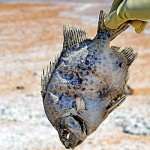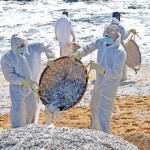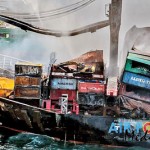News
Gruelling effort to connect the dots that could damn the X-Press Pearl
- The damage from the X-Press Pearl is still being assessed
Scientists painstakingly collecting and testing the evidence in Sri Lanka’s worst maritime disaster say the work is “an eye-opener” for a country new to dealing with cases of catastrophe in its waters.
The environmental impact assessment of the X-Press Pearl which caught fire and sank off the coast of Colombo in May is currently underway under a 40-member expert panel. The committee is due to complete the first stage of its evaluation at the end of November.
While 22 officers aboard the ship had been arrested in relation to the incident initially, 15 have since been released, with three getting their travel bans lifted on Thursday. The captain, first and second engineers, and chief officer are among the seven officials still in custody. Investigations into any negligence are ongoing.
Sri Lankan authorities seeking scientific evidence that could pin down culpability for the damage to the country’s maritime environment, and the resulting loss of livelihood to fishermen, are collaborating with local and international laboratories over analytical reports. Samples have been sent to UK and discussions are underway with two laboratories in France and Australia.
Representatives of the National Aquatic Resources Research and Development Agency, the National Building Research Organisation, and the universities of Moratuwa, Ruhuna, Kelaniya and Jayawardenapura are at the site, collecting fish, water, sediment and air quality samples.
“The damage report constructed using this information will have to be connected to the X-Press Pearl,” Professor Terney Pradeep Kumara of the Department of Oceanography, University of Ruhuna said. “If they find high-toxic chemicals in the water, the scientists will go to the ship’s cargo list and see if the ship was carrying this chemical.”
The civil case would involve local authorities having to defend and justify claims for compensation. “Our first task is to come up with an extremely scientific report,” the professor noted. Next, the damage will have to be converted into monetary values by a team of environmental economists.
“Marine disaster cases are quite new to Sri Lanka so we’re still learning; this was an eye opener,” Professor Pradeep Kumara admitted.
Prof Ajith De Alwis, Dean of Postgraduate Studies, Moratuwa University, and Prof Prasanthi Gunawardena, Senior Lecturer, Jayawardenapura University, head the team of experts evaluating the extent of the environmental damage caused by the wreck. The panel consists of nearly 40 experts representing 14 institutions.
“The group is conducting research under allocated thematic areas,” the Chairman of the Marine Environment Protection Authority (MEPA), attorney-at-law Darshani Lahandapura, said.
Meanwhile, the cleanup process continues: every day, MEPA regional staff conduct shoreline assessments and collect data on the locations of the pollution.
They are hampered by the fact that the pollution is continuous. A field visit conducted by officials on Sarakkuwa on Thursday showed significant wreck-related pollution despite the fact that more than 120 days have passed since May 26, 2021 when the cleanup commenced.
“We have put in 33,000-plus man days for the cleanup process,” Ms Lahandapura said.
The collected waste was being stored at two sites: a container yard with 45 containers full of waste and another warehouse with more than 53,000 sacks of debris from the vessel. “We have to store these things for our investigative processes and the calculations we need to make,” the MEPA Chairman said.
MEPA has deployed a machine that can segregate plastic nurdles (pellets) that were in the X-Press Pearl’s cargo from sea sand, shells and other objects in the Sarakkuwa area.
Ms Lahandapura said the oil spill from the ship showed like a metallic, rainbow-hued “sheen”, an iridescent appearance of oil, on the surface of the water. The internationally recognised method of minimising a sheen was mechanical dispersion, which was being done, she said.
According to the Bonn Convention, when analysts are unable to visit the location of the sheen to obtain physical samples, they are guided to make decisions on its source based on its colour. “This range of colours essentially confirmed that it wasn’t bunker oil, which is what we were most afraid of since it is more hazardous,” the MEPA Chairman said.
The sheen is also decreasing significantly. Authorities noted that the sheen which spanned across 1-2 nautical miles has become smaller and has never reached the shore.
“What happens is that the oil evaporates after a while, so what we do is something akin to churning with propellers to accelerate the evaporation process,” Ms Lahandapura said. According to international authorities in countries such as Japan, mechanical dispersion is the most effective method available for the mitigation of an oil sheen.
Chemical dispersion was not an available option as the sea at the site was too shallow. Chemical dispersion at a depth of less than 25m would damage the seabed. The slick was also too thin for the use of booms.
At the last count, on September 20, a total of 329 turtles, 36 dolphins and 7 whales had died in circumstances that could be related to the X-Press Pearl accident. Seven sick turtles are under the care of the Wildlife Conservation Department.
The fishing community is still in severe hardship since the ban on fishing in the area is still in force. Fishermen from Panadura to Negombo have not been allowed to fish in the polluted waters for months.
Local authorities are receiving United Nations expertise on risk mitigation and environmental damage reduction practices. A report released by a UN team of experts outlined recommendations that are being largely followed by the local authorities.
The report noted that the extensive sampling being conducted and the parameters that this will set would assist the government in formulating the design for a longer-term monitoring program of the marine environment. This was important not only to track this disaster’s ecological impacts but also to obtain insight on baseline conditions which are essential for conducting scientific assessment and remediation of future maritime incidents.
“A sound knowledge base is also a central requirement for litigation and damage and loss assessment,” the report stated.
| How the claims are being run Sri Lanka has received $US3.6 million (Rs. 720 million) of an initial claim of $US40 million against the X-Press Pearl’s owners over the damage allegedly created by the ship accident. Families in the fishing community whose livelihood was destroyed by the sea pollution from the accident have received Rs. 400 million of this amount. The Fisheries Ministry has submitted further claims aimed at the distribution of more reparations for these victims. The country’s compensation action is in two parts: one for the expenses incurred in putting out the fire and controlling damage between May 20 to July 2. The second component covers “anticipated costs” for future expenses. The claims are being sent to the X-Press Pearl’s insurers, the London P and I Club (P and I stands for protection and indemnity insurance). “What the P and I Club advised us to do is, firstly, to submit the invoices for our actual expenses, which we have done through the Attorney-General, who has in turn handed them over to the lawyers of the P and I club,” Marine Environment Protection Authority (MEPA) chief Darshani Lahandapura said. “Secondly, they advised against claiming anticipated costs since two to three months had elapsed since the wreck. They recommend instead that we submit invoices for the rest of the expenses as well. We are now preparing a second claim from June 2 up to August 31.” Compensation claims for the environmental damage will follow once the damage has been assessed, she said.
| |
| Beefed-up Act will push Lanka to enter crucial treatiesWith the revamped Marine Environment Protection Authority (MEPA) Act now in the final stages of review by a panel of maritime law experts, the authority’s chief said it was “high time” Sri Lanka signed on to crucial conventions and part-conventions.MEPA Chairman Darshani Lahandapura, however, rejected claims that current loopholes had hobbled the country’s battle for compensation over the X-Press Pearl sinking. “While there are amendments that need to be made, the MEPA Act is a powerful one,” Ms. Lahandapura said. “Provisions are set out for criminal liability and civil liability. Under civil liability we can claim damages for cleanups and the environmental losses. “However, there are other important conventions that we are not party to, such as the Nairobi Convention on the removal of wrecks, and the Hazardous and Noxious Substances (H and S) by Sea Convention.” She noted that another challenge was the lag between signing conventions and inculcating convention provisions into local practices through resource allocation and domestic laws. “These are all issues that have been addressed through the proposed new Act that is to come out shortly,” she said. One notable omission was the fact that Sri Lanka was not party to Annex VI of the International Convention for the Prevention of Pollution from Ships (MARPOL), which is the main international convention covering prevention of pollution of the marine environment by ships from operational or accidental causes. This annexure, as the International Marine Organisation states, limits the main air pollutants contained in ships exhaust gas, including sulphur oxides and nitrous oxides), and prohibits deliberate emissions of ozone depleting substances. |




